Enterprise Resource Planning (ERP) System Comparison Report
VerifiedAdded on 2021/05/31
|20
|4489
|262
Report
AI Summary
This report provides a comprehensive comparison of three main types of Enterprise Resource Planning (ERP) systems: on-premise, hosted, and cloud-based ERP. The introduction defines ERP and its role in modern business operations. The report then delves into the specifics of each ERP system, discussing the benefits and weaknesses of each approach. For on-premise ERP, the benefits of data control, less vendor dependency, limited ongoing costs, and easier customization are highlighted, while the high initial and maintenance costs and security concerns are presented as weaknesses. The hosted ERP system is then examined, focusing on the advantages of scalability, minimized hardware maintenance, flexibility, and reduced downtime, while the report also addresses the problems of accessibility and sharing, integration issues, and change management challenges. Finally, the cloud ERP system is analyzed, emphasizing lower upfront investment costs, automatic software upgrades, flexibility, and reduced dependence on internal IT resources as benefits, while limited customization, data security risks, and potentially higher long-term expenses are presented as drawbacks. Examples such as Oracle Database are provided to illustrate the concepts. The report concludes with a summary of the key findings and a comparison of the three ERP systems, providing valuable insights for businesses considering ERP implementation.
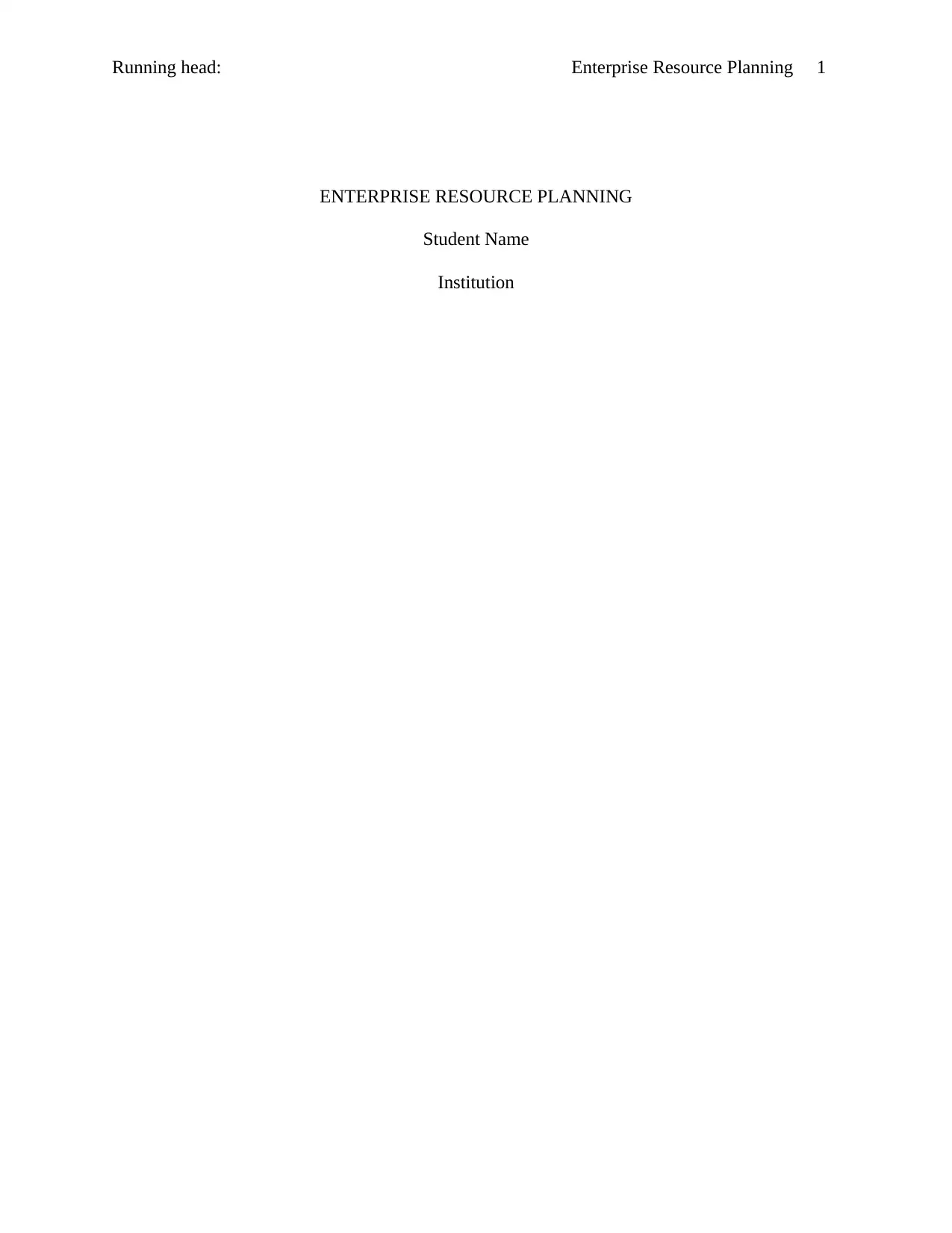
Running head: Enterprise Resource Planning 1
ENTERPRISE RESOURCE PLANNING
Student Name
Institution
ENTERPRISE RESOURCE PLANNING
Student Name
Institution
Paraphrase This Document
Need a fresh take? Get an instant paraphrase of this document with our AI Paraphraser
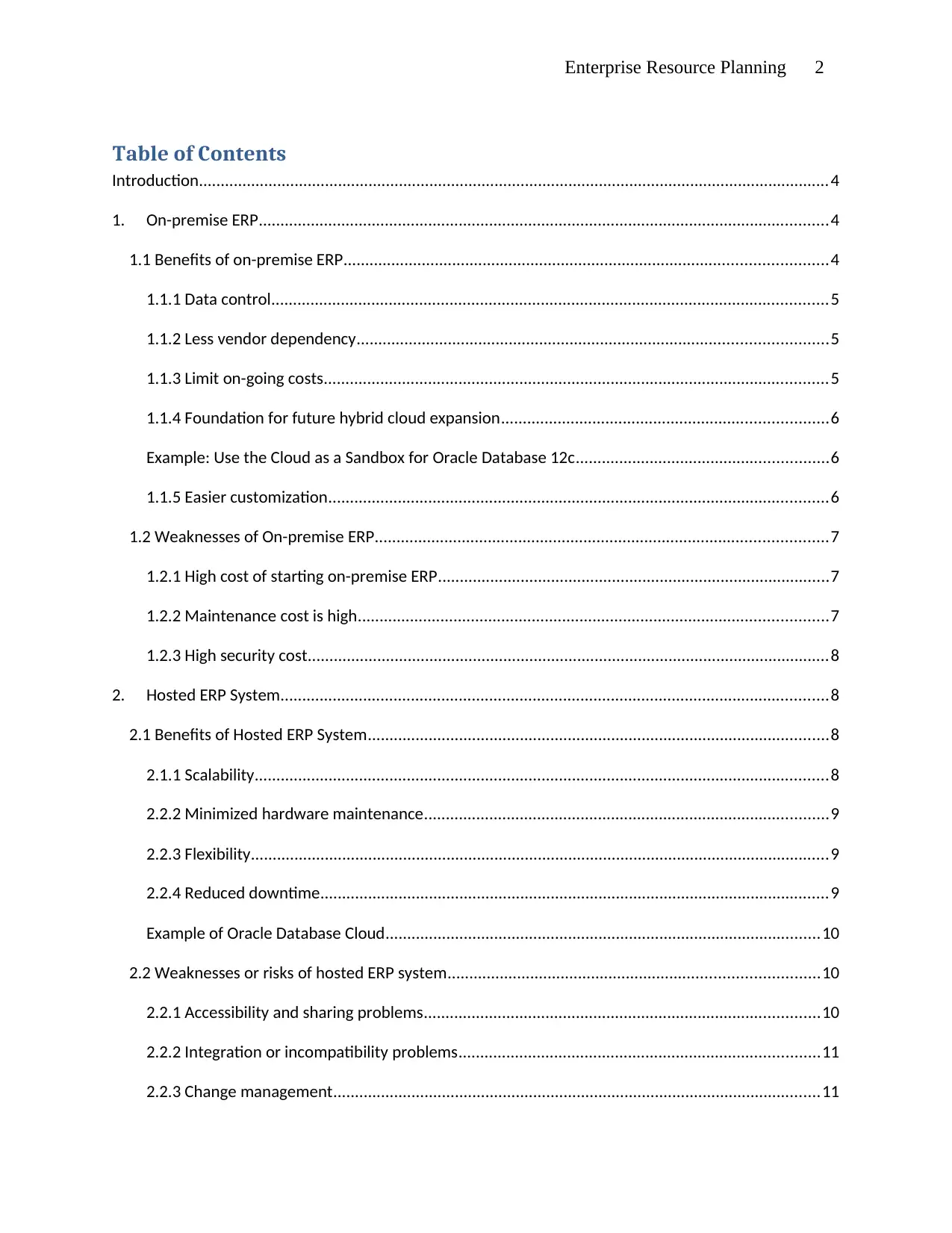
Enterprise Resource Planning 2
Table of Contents
Introduction.................................................................................................................................................4
1. On-premise ERP...................................................................................................................................4
1.1 Benefits of on-premise ERP...............................................................................................................4
1.1.1 Data control................................................................................................................................5
1.1.2 Less vendor dependency............................................................................................................5
1.1.3 Limit on-going costs....................................................................................................................5
1.1.4 Foundation for future hybrid cloud expansion...........................................................................6
Example: Use the Cloud as a Sandbox for Oracle Database 12c..........................................................6
1.1.5 Easier customization...................................................................................................................6
1.2 Weaknesses of On-premise ERP........................................................................................................7
1.2.1 High cost of starting on-premise ERP..........................................................................................7
1.2.2 Maintenance cost is high............................................................................................................7
1.2.3 High security cost........................................................................................................................8
2. Hosted ERP System..............................................................................................................................8
2.1 Benefits of Hosted ERP System..........................................................................................................8
2.1.1 Scalability....................................................................................................................................8
2.2.2 Minimized hardware maintenance.............................................................................................9
2.2.3 Flexibility.....................................................................................................................................9
2.2.4 Reduced downtime.....................................................................................................................9
Example of Oracle Database Cloud....................................................................................................10
2.2 Weaknesses or risks of hosted ERP system.....................................................................................10
2.2.1 Accessibility and sharing problems...........................................................................................10
2.2.2 Integration or incompatibility problems...................................................................................11
2.2.3 Change management................................................................................................................11
Table of Contents
Introduction.................................................................................................................................................4
1. On-premise ERP...................................................................................................................................4
1.1 Benefits of on-premise ERP...............................................................................................................4
1.1.1 Data control................................................................................................................................5
1.1.2 Less vendor dependency............................................................................................................5
1.1.3 Limit on-going costs....................................................................................................................5
1.1.4 Foundation for future hybrid cloud expansion...........................................................................6
Example: Use the Cloud as a Sandbox for Oracle Database 12c..........................................................6
1.1.5 Easier customization...................................................................................................................6
1.2 Weaknesses of On-premise ERP........................................................................................................7
1.2.1 High cost of starting on-premise ERP..........................................................................................7
1.2.2 Maintenance cost is high............................................................................................................7
1.2.3 High security cost........................................................................................................................8
2. Hosted ERP System..............................................................................................................................8
2.1 Benefits of Hosted ERP System..........................................................................................................8
2.1.1 Scalability....................................................................................................................................8
2.2.2 Minimized hardware maintenance.............................................................................................9
2.2.3 Flexibility.....................................................................................................................................9
2.2.4 Reduced downtime.....................................................................................................................9
Example of Oracle Database Cloud....................................................................................................10
2.2 Weaknesses or risks of hosted ERP system.....................................................................................10
2.2.1 Accessibility and sharing problems...........................................................................................10
2.2.2 Integration or incompatibility problems...................................................................................11
2.2.3 Change management................................................................................................................11
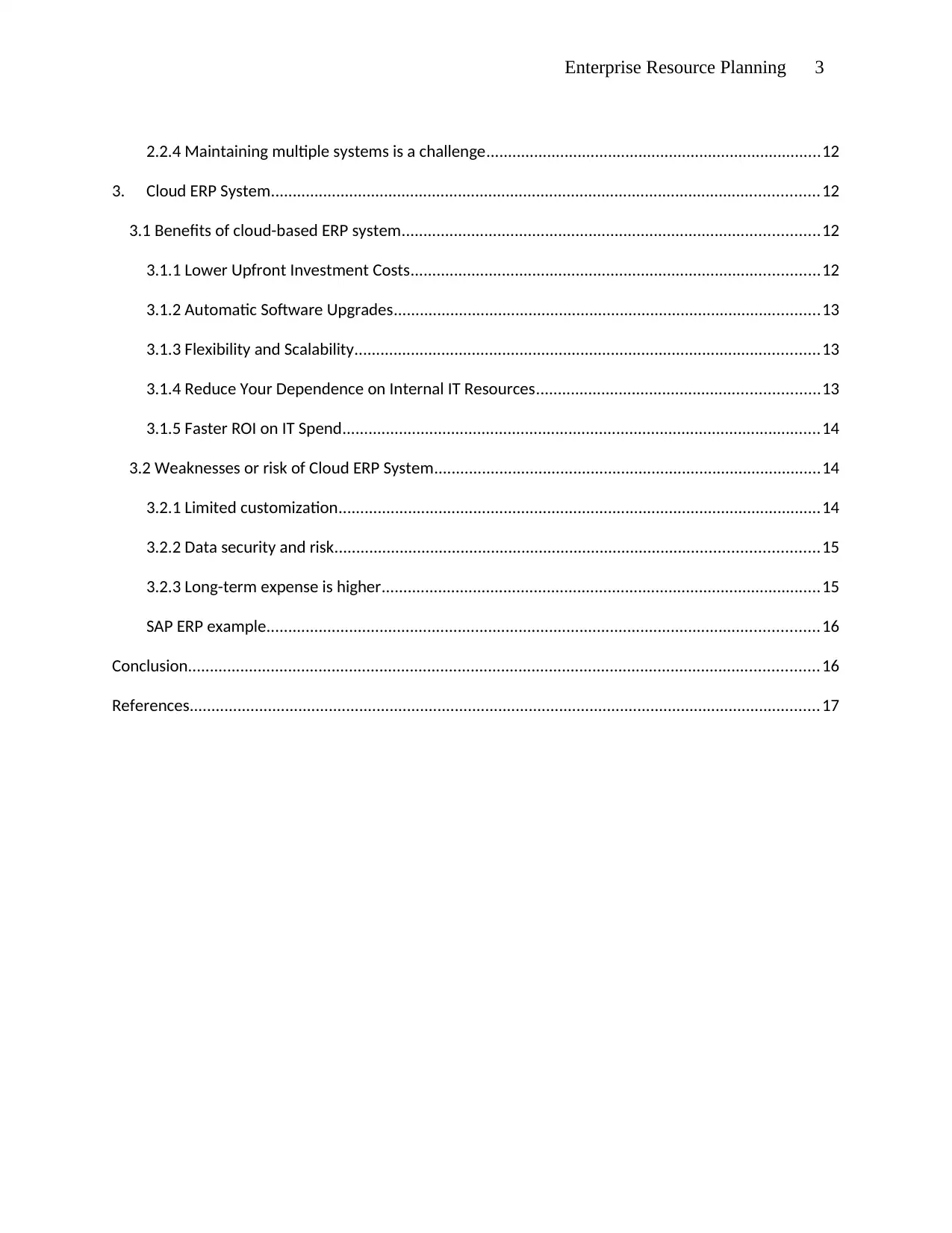
Enterprise Resource Planning 3
2.2.4 Maintaining multiple systems is a challenge.............................................................................12
3. Cloud ERP System..............................................................................................................................12
3.1 Benefits of cloud-based ERP system................................................................................................12
3.1.1 Lower Upfront Investment Costs..............................................................................................12
3.1.2 Automatic Software Upgrades..................................................................................................13
3.1.3 Flexibility and Scalability...........................................................................................................13
3.1.4 Reduce Your Dependence on Internal IT Resources.................................................................13
3.1.5 Faster ROI on IT Spend..............................................................................................................14
3.2 Weaknesses or risk of Cloud ERP System.........................................................................................14
3.2.1 Limited customization...............................................................................................................14
3.2.2 Data security and risk...............................................................................................................15
3.2.3 Long-term expense is higher.....................................................................................................15
SAP ERP example...............................................................................................................................16
Conclusion.................................................................................................................................................16
References.................................................................................................................................................17
2.2.4 Maintaining multiple systems is a challenge.............................................................................12
3. Cloud ERP System..............................................................................................................................12
3.1 Benefits of cloud-based ERP system................................................................................................12
3.1.1 Lower Upfront Investment Costs..............................................................................................12
3.1.2 Automatic Software Upgrades..................................................................................................13
3.1.3 Flexibility and Scalability...........................................................................................................13
3.1.4 Reduce Your Dependence on Internal IT Resources.................................................................13
3.1.5 Faster ROI on IT Spend..............................................................................................................14
3.2 Weaknesses or risk of Cloud ERP System.........................................................................................14
3.2.1 Limited customization...............................................................................................................14
3.2.2 Data security and risk...............................................................................................................15
3.2.3 Long-term expense is higher.....................................................................................................15
SAP ERP example...............................................................................................................................16
Conclusion.................................................................................................................................................16
References.................................................................................................................................................17
⊘ This is a preview!⊘
Do you want full access?
Subscribe today to unlock all pages.

Trusted by 1+ million students worldwide
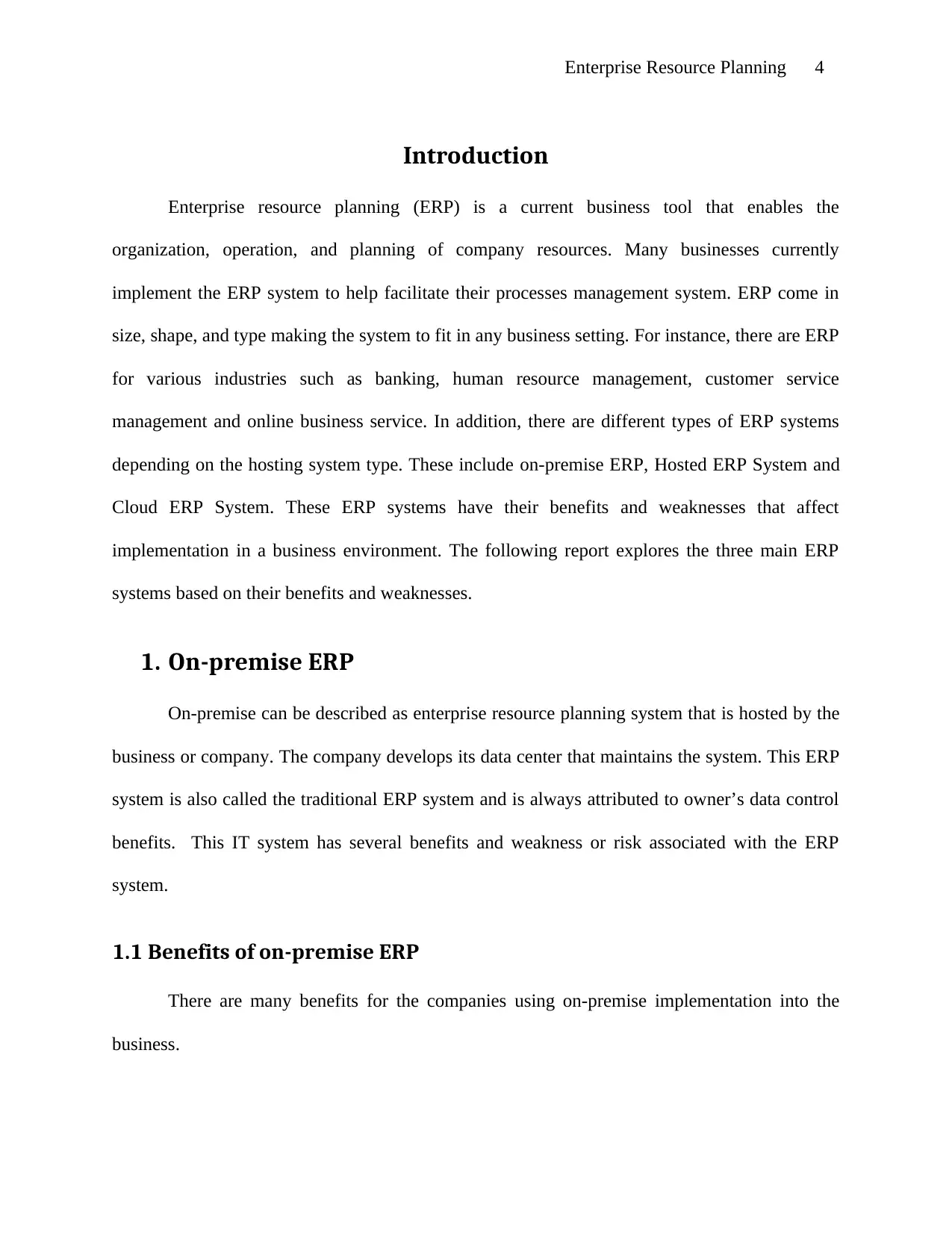
Enterprise Resource Planning 4
Introduction
Enterprise resource planning (ERP) is a current business tool that enables the
organization, operation, and planning of company resources. Many businesses currently
implement the ERP system to help facilitate their processes management system. ERP come in
size, shape, and type making the system to fit in any business setting. For instance, there are ERP
for various industries such as banking, human resource management, customer service
management and online business service. In addition, there are different types of ERP systems
depending on the hosting system type. These include on-premise ERP, Hosted ERP System and
Cloud ERP System. These ERP systems have their benefits and weaknesses that affect
implementation in a business environment. The following report explores the three main ERP
systems based on their benefits and weaknesses.
1. On-premise ERP
On-premise can be described as enterprise resource planning system that is hosted by the
business or company. The company develops its data center that maintains the system. This ERP
system is also called the traditional ERP system and is always attributed to owner’s data control
benefits. This IT system has several benefits and weakness or risk associated with the ERP
system.
1.1 Benefits of on-premise ERP
There are many benefits for the companies using on-premise implementation into the
business.
Introduction
Enterprise resource planning (ERP) is a current business tool that enables the
organization, operation, and planning of company resources. Many businesses currently
implement the ERP system to help facilitate their processes management system. ERP come in
size, shape, and type making the system to fit in any business setting. For instance, there are ERP
for various industries such as banking, human resource management, customer service
management and online business service. In addition, there are different types of ERP systems
depending on the hosting system type. These include on-premise ERP, Hosted ERP System and
Cloud ERP System. These ERP systems have their benefits and weaknesses that affect
implementation in a business environment. The following report explores the three main ERP
systems based on their benefits and weaknesses.
1. On-premise ERP
On-premise can be described as enterprise resource planning system that is hosted by the
business or company. The company develops its data center that maintains the system. This ERP
system is also called the traditional ERP system and is always attributed to owner’s data control
benefits. This IT system has several benefits and weakness or risk associated with the ERP
system.
1.1 Benefits of on-premise ERP
There are many benefits for the companies using on-premise implementation into the
business.
Paraphrase This Document
Need a fresh take? Get an instant paraphrase of this document with our AI Paraphraser
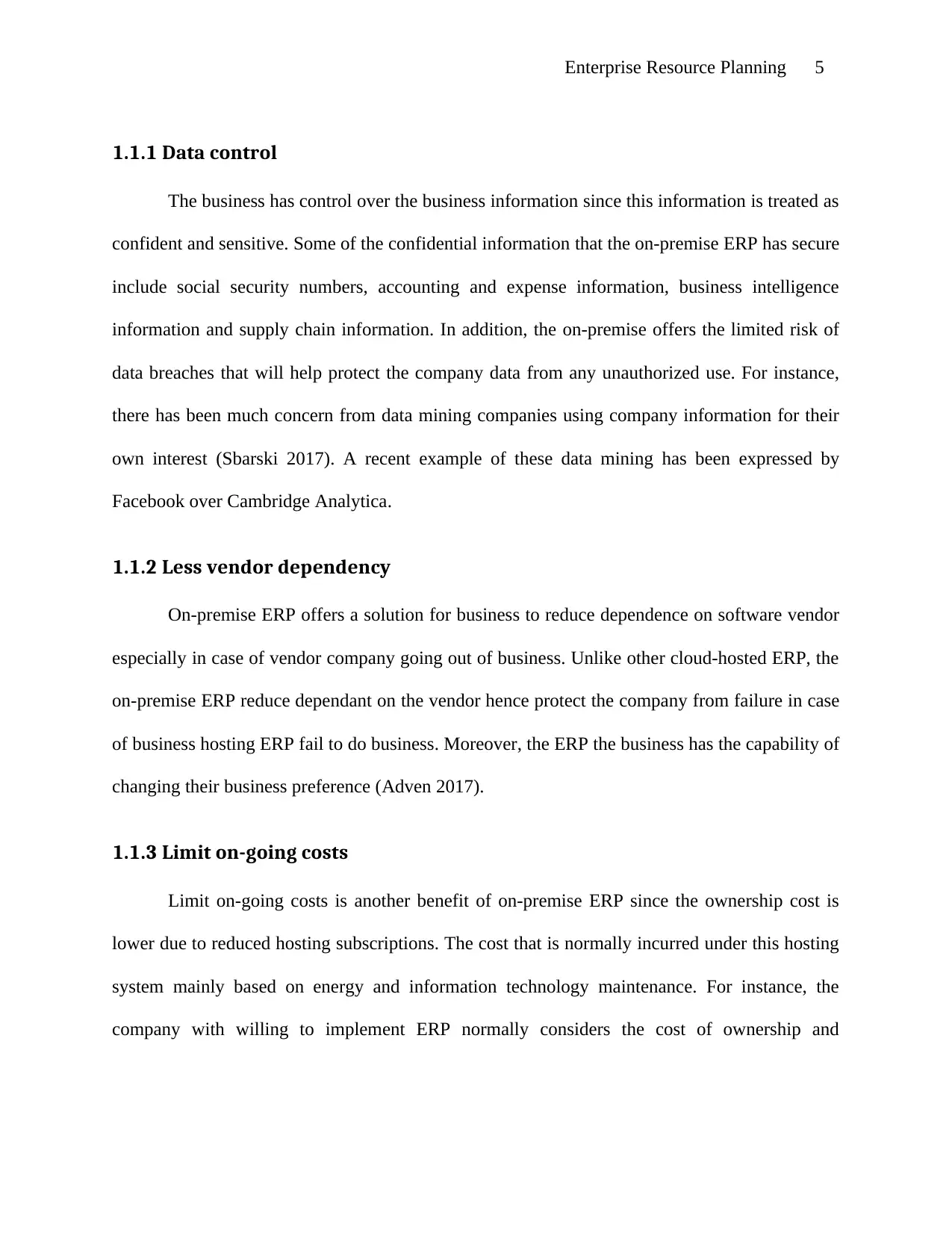
Enterprise Resource Planning 5
1.1.1 Data control
The business has control over the business information since this information is treated as
confident and sensitive. Some of the confidential information that the on-premise ERP has secure
include social security numbers, accounting and expense information, business intelligence
information and supply chain information. In addition, the on-premise offers the limited risk of
data breaches that will help protect the company data from any unauthorized use. For instance,
there has been much concern from data mining companies using company information for their
own interest (Sbarski 2017). A recent example of these data mining has been expressed by
Facebook over Cambridge Analytica.
1.1.2 Less vendor dependency
On-premise ERP offers a solution for business to reduce dependence on software vendor
especially in case of vendor company going out of business. Unlike other cloud-hosted ERP, the
on-premise ERP reduce dependant on the vendor hence protect the company from failure in case
of business hosting ERP fail to do business. Moreover, the ERP the business has the capability of
changing their business preference (Adven 2017).
1.1.3 Limit on-going costs
Limit on-going costs is another benefit of on-premise ERP since the ownership cost is
lower due to reduced hosting subscriptions. The cost that is normally incurred under this hosting
system mainly based on energy and information technology maintenance. For instance, the
company with willing to implement ERP normally considers the cost of ownership and
1.1.1 Data control
The business has control over the business information since this information is treated as
confident and sensitive. Some of the confidential information that the on-premise ERP has secure
include social security numbers, accounting and expense information, business intelligence
information and supply chain information. In addition, the on-premise offers the limited risk of
data breaches that will help protect the company data from any unauthorized use. For instance,
there has been much concern from data mining companies using company information for their
own interest (Sbarski 2017). A recent example of these data mining has been expressed by
Facebook over Cambridge Analytica.
1.1.2 Less vendor dependency
On-premise ERP offers a solution for business to reduce dependence on software vendor
especially in case of vendor company going out of business. Unlike other cloud-hosted ERP, the
on-premise ERP reduce dependant on the vendor hence protect the company from failure in case
of business hosting ERP fail to do business. Moreover, the ERP the business has the capability of
changing their business preference (Adven 2017).
1.1.3 Limit on-going costs
Limit on-going costs is another benefit of on-premise ERP since the ownership cost is
lower due to reduced hosting subscriptions. The cost that is normally incurred under this hosting
system mainly based on energy and information technology maintenance. For instance, the
company with willing to implement ERP normally considers the cost of ownership and
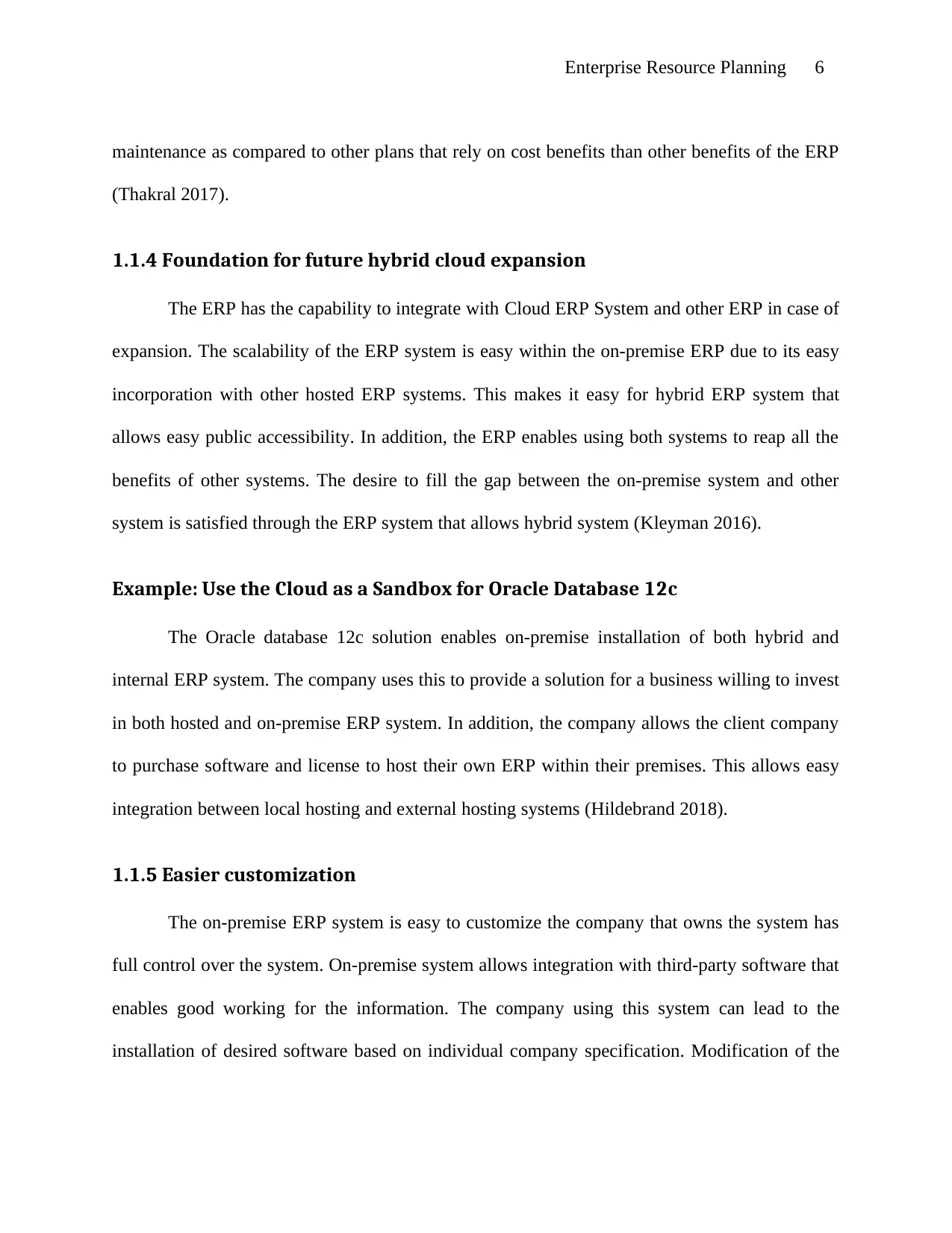
Enterprise Resource Planning 6
maintenance as compared to other plans that rely on cost benefits than other benefits of the ERP
(Thakral 2017).
1.1.4 Foundation for future hybrid cloud expansion
The ERP has the capability to integrate with Cloud ERP System and other ERP in case of
expansion. The scalability of the ERP system is easy within the on-premise ERP due to its easy
incorporation with other hosted ERP systems. This makes it easy for hybrid ERP system that
allows easy public accessibility. In addition, the ERP enables using both systems to reap all the
benefits of other systems. The desire to fill the gap between the on-premise system and other
system is satisfied through the ERP system that allows hybrid system (Kleyman 2016).
Example: Use the Cloud as a Sandbox for Oracle Database 12c
The Oracle database 12c solution enables on-premise installation of both hybrid and
internal ERP system. The company uses this to provide a solution for a business willing to invest
in both hosted and on-premise ERP system. In addition, the company allows the client company
to purchase software and license to host their own ERP within their premises. This allows easy
integration between local hosting and external hosting systems (Hildebrand 2018).
1.1.5 Easier customization
The on-premise ERP system is easy to customize the company that owns the system has
full control over the system. On-premise system allows integration with third-party software that
enables good working for the information. The company using this system can lead to the
installation of desired software based on individual company specification. Modification of the
maintenance as compared to other plans that rely on cost benefits than other benefits of the ERP
(Thakral 2017).
1.1.4 Foundation for future hybrid cloud expansion
The ERP has the capability to integrate with Cloud ERP System and other ERP in case of
expansion. The scalability of the ERP system is easy within the on-premise ERP due to its easy
incorporation with other hosted ERP systems. This makes it easy for hybrid ERP system that
allows easy public accessibility. In addition, the ERP enables using both systems to reap all the
benefits of other systems. The desire to fill the gap between the on-premise system and other
system is satisfied through the ERP system that allows hybrid system (Kleyman 2016).
Example: Use the Cloud as a Sandbox for Oracle Database 12c
The Oracle database 12c solution enables on-premise installation of both hybrid and
internal ERP system. The company uses this to provide a solution for a business willing to invest
in both hosted and on-premise ERP system. In addition, the company allows the client company
to purchase software and license to host their own ERP within their premises. This allows easy
integration between local hosting and external hosting systems (Hildebrand 2018).
1.1.5 Easier customization
The on-premise ERP system is easy to customize the company that owns the system has
full control over the system. On-premise system allows integration with third-party software that
enables good working for the information. The company using this system can lead to the
installation of desired software based on individual company specification. Modification of the
⊘ This is a preview!⊘
Do you want full access?
Subscribe today to unlock all pages.

Trusted by 1+ million students worldwide
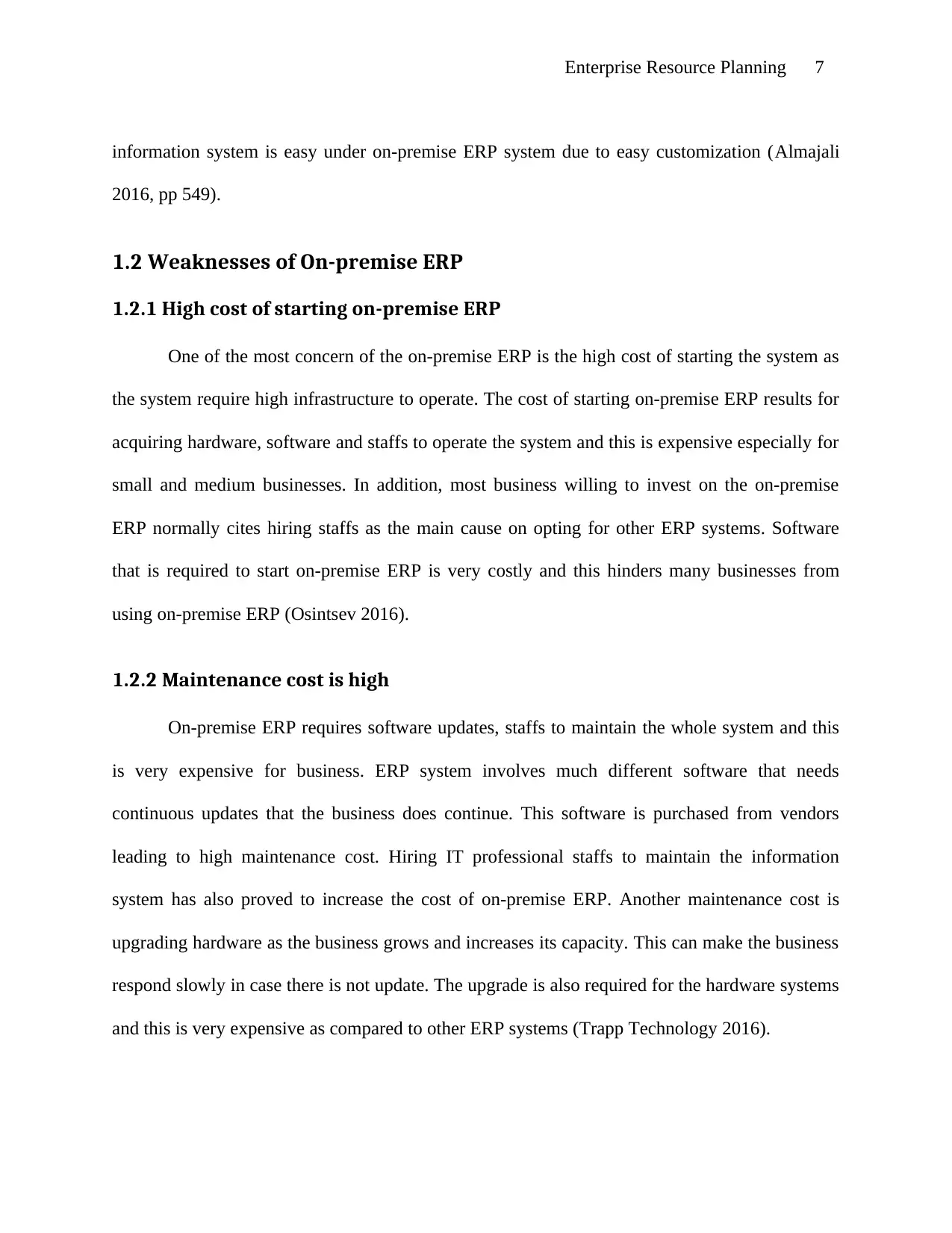
Enterprise Resource Planning 7
information system is easy under on-premise ERP system due to easy customization (Almajali
2016, pp 549).
1.2 Weaknesses of On-premise ERP
1.2.1 High cost of starting on-premise ERP
One of the most concern of the on-premise ERP is the high cost of starting the system as
the system require high infrastructure to operate. The cost of starting on-premise ERP results for
acquiring hardware, software and staffs to operate the system and this is expensive especially for
small and medium businesses. In addition, most business willing to invest on the on-premise
ERP normally cites hiring staffs as the main cause on opting for other ERP systems. Software
that is required to start on-premise ERP is very costly and this hinders many businesses from
using on-premise ERP (Osintsev 2016).
1.2.2 Maintenance cost is high
On-premise ERP requires software updates, staffs to maintain the whole system and this
is very expensive for business. ERP system involves much different software that needs
continuous updates that the business does continue. This software is purchased from vendors
leading to high maintenance cost. Hiring IT professional staffs to maintain the information
system has also proved to increase the cost of on-premise ERP. Another maintenance cost is
upgrading hardware as the business grows and increases its capacity. This can make the business
respond slowly in case there is not update. The upgrade is also required for the hardware systems
and this is very expensive as compared to other ERP systems (Trapp Technology 2016).
information system is easy under on-premise ERP system due to easy customization (Almajali
2016, pp 549).
1.2 Weaknesses of On-premise ERP
1.2.1 High cost of starting on-premise ERP
One of the most concern of the on-premise ERP is the high cost of starting the system as
the system require high infrastructure to operate. The cost of starting on-premise ERP results for
acquiring hardware, software and staffs to operate the system and this is expensive especially for
small and medium businesses. In addition, most business willing to invest on the on-premise
ERP normally cites hiring staffs as the main cause on opting for other ERP systems. Software
that is required to start on-premise ERP is very costly and this hinders many businesses from
using on-premise ERP (Osintsev 2016).
1.2.2 Maintenance cost is high
On-premise ERP requires software updates, staffs to maintain the whole system and this
is very expensive for business. ERP system involves much different software that needs
continuous updates that the business does continue. This software is purchased from vendors
leading to high maintenance cost. Hiring IT professional staffs to maintain the information
system has also proved to increase the cost of on-premise ERP. Another maintenance cost is
upgrading hardware as the business grows and increases its capacity. This can make the business
respond slowly in case there is not update. The upgrade is also required for the hardware systems
and this is very expensive as compared to other ERP systems (Trapp Technology 2016).
Paraphrase This Document
Need a fresh take? Get an instant paraphrase of this document with our AI Paraphraser
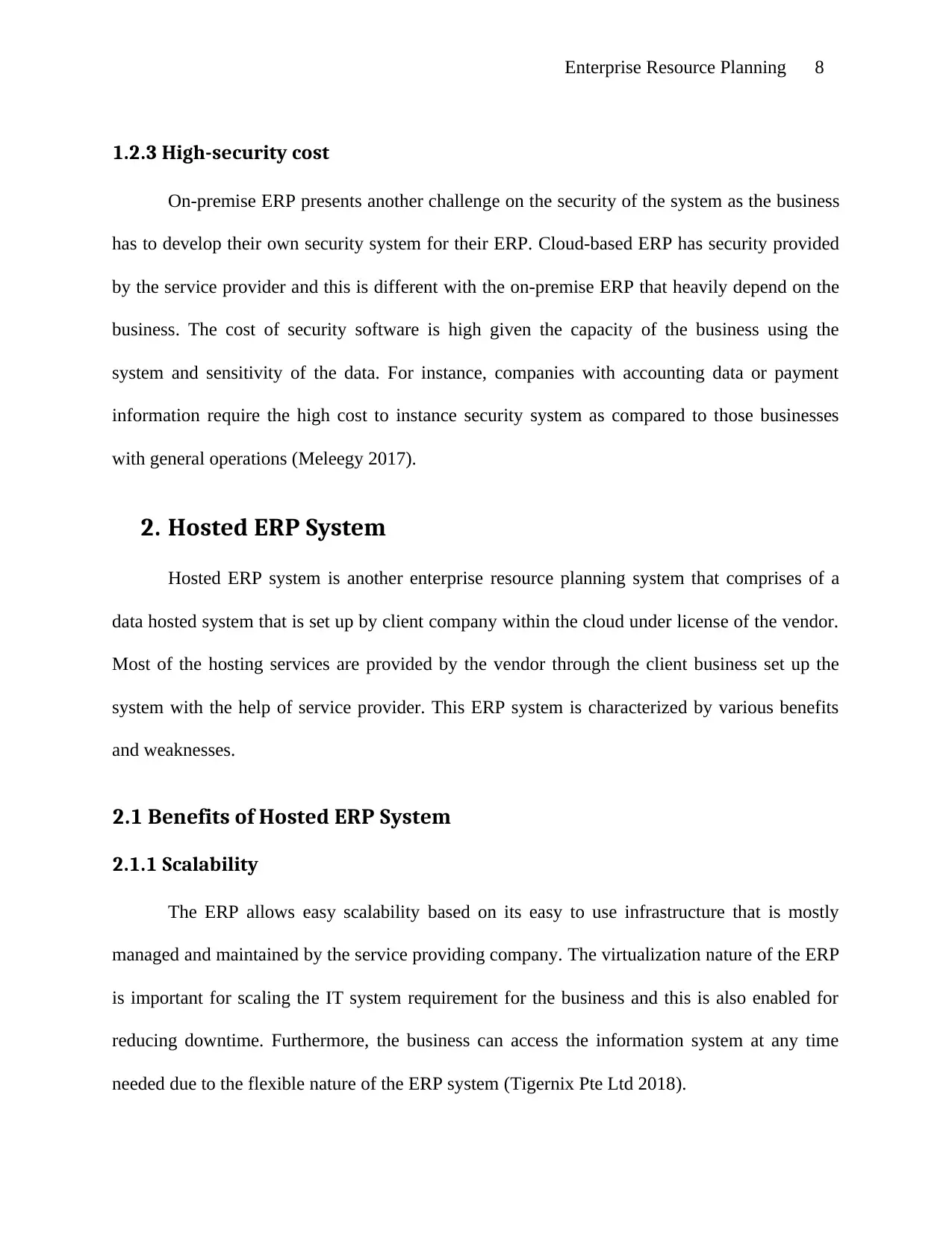
Enterprise Resource Planning 8
1.2.3 High-security cost
On-premise ERP presents another challenge on the security of the system as the business
has to develop their own security system for their ERP. Cloud-based ERP has security provided
by the service provider and this is different with the on-premise ERP that heavily depend on the
business. The cost of security software is high given the capacity of the business using the
system and sensitivity of the data. For instance, companies with accounting data or payment
information require the high cost to instance security system as compared to those businesses
with general operations (Meleegy 2017).
2. Hosted ERP System
Hosted ERP system is another enterprise resource planning system that comprises of a
data hosted system that is set up by client company within the cloud under license of the vendor.
Most of the hosting services are provided by the vendor through the client business set up the
system with the help of service provider. This ERP system is characterized by various benefits
and weaknesses.
2.1 Benefits of Hosted ERP System
2.1.1 Scalability
The ERP allows easy scalability based on its easy to use infrastructure that is mostly
managed and maintained by the service providing company. The virtualization nature of the ERP
is important for scaling the IT system requirement for the business and this is also enabled for
reducing downtime. Furthermore, the business can access the information system at any time
needed due to the flexible nature of the ERP system (Tigernix Pte Ltd 2018).
1.2.3 High-security cost
On-premise ERP presents another challenge on the security of the system as the business
has to develop their own security system for their ERP. Cloud-based ERP has security provided
by the service provider and this is different with the on-premise ERP that heavily depend on the
business. The cost of security software is high given the capacity of the business using the
system and sensitivity of the data. For instance, companies with accounting data or payment
information require the high cost to instance security system as compared to those businesses
with general operations (Meleegy 2017).
2. Hosted ERP System
Hosted ERP system is another enterprise resource planning system that comprises of a
data hosted system that is set up by client company within the cloud under license of the vendor.
Most of the hosting services are provided by the vendor through the client business set up the
system with the help of service provider. This ERP system is characterized by various benefits
and weaknesses.
2.1 Benefits of Hosted ERP System
2.1.1 Scalability
The ERP allows easy scalability based on its easy to use infrastructure that is mostly
managed and maintained by the service providing company. The virtualization nature of the ERP
is important for scaling the IT system requirement for the business and this is also enabled for
reducing downtime. Furthermore, the business can access the information system at any time
needed due to the flexible nature of the ERP system (Tigernix Pte Ltd 2018).
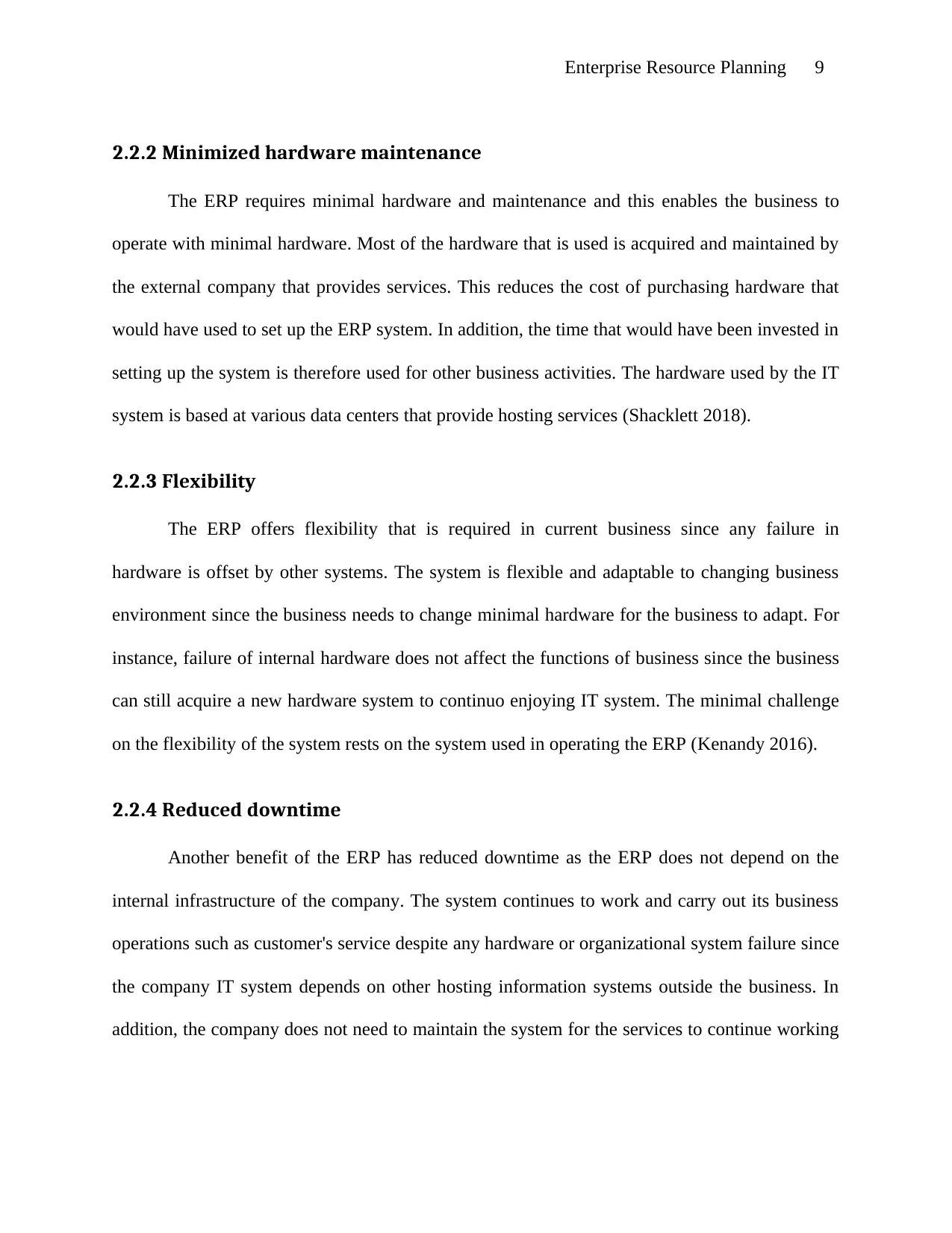
Enterprise Resource Planning 9
2.2.2 Minimized hardware maintenance
The ERP requires minimal hardware and maintenance and this enables the business to
operate with minimal hardware. Most of the hardware that is used is acquired and maintained by
the external company that provides services. This reduces the cost of purchasing hardware that
would have used to set up the ERP system. In addition, the time that would have been invested in
setting up the system is therefore used for other business activities. The hardware used by the IT
system is based at various data centers that provide hosting services (Shacklett 2018).
2.2.3 Flexibility
The ERP offers flexibility that is required in current business since any failure in
hardware is offset by other systems. The system is flexible and adaptable to changing business
environment since the business needs to change minimal hardware for the business to adapt. For
instance, failure of internal hardware does not affect the functions of business since the business
can still acquire a new hardware system to continuo enjoying IT system. The minimal challenge
on the flexibility of the system rests on the system used in operating the ERP (Kenandy 2016).
2.2.4 Reduced downtime
Another benefit of the ERP has reduced downtime as the ERP does not depend on the
internal infrastructure of the company. The system continues to work and carry out its business
operations such as customer's service despite any hardware or organizational system failure since
the company IT system depends on other hosting information systems outside the business. In
addition, the company does not need to maintain the system for the services to continue working
2.2.2 Minimized hardware maintenance
The ERP requires minimal hardware and maintenance and this enables the business to
operate with minimal hardware. Most of the hardware that is used is acquired and maintained by
the external company that provides services. This reduces the cost of purchasing hardware that
would have used to set up the ERP system. In addition, the time that would have been invested in
setting up the system is therefore used for other business activities. The hardware used by the IT
system is based at various data centers that provide hosting services (Shacklett 2018).
2.2.3 Flexibility
The ERP offers flexibility that is required in current business since any failure in
hardware is offset by other systems. The system is flexible and adaptable to changing business
environment since the business needs to change minimal hardware for the business to adapt. For
instance, failure of internal hardware does not affect the functions of business since the business
can still acquire a new hardware system to continuo enjoying IT system. The minimal challenge
on the flexibility of the system rests on the system used in operating the ERP (Kenandy 2016).
2.2.4 Reduced downtime
Another benefit of the ERP has reduced downtime as the ERP does not depend on the
internal infrastructure of the company. The system continues to work and carry out its business
operations such as customer's service despite any hardware or organizational system failure since
the company IT system depends on other hosting information systems outside the business. In
addition, the company does not need to maintain the system for the services to continue working
⊘ This is a preview!⊘
Do you want full access?
Subscribe today to unlock all pages.

Trusted by 1+ million students worldwide
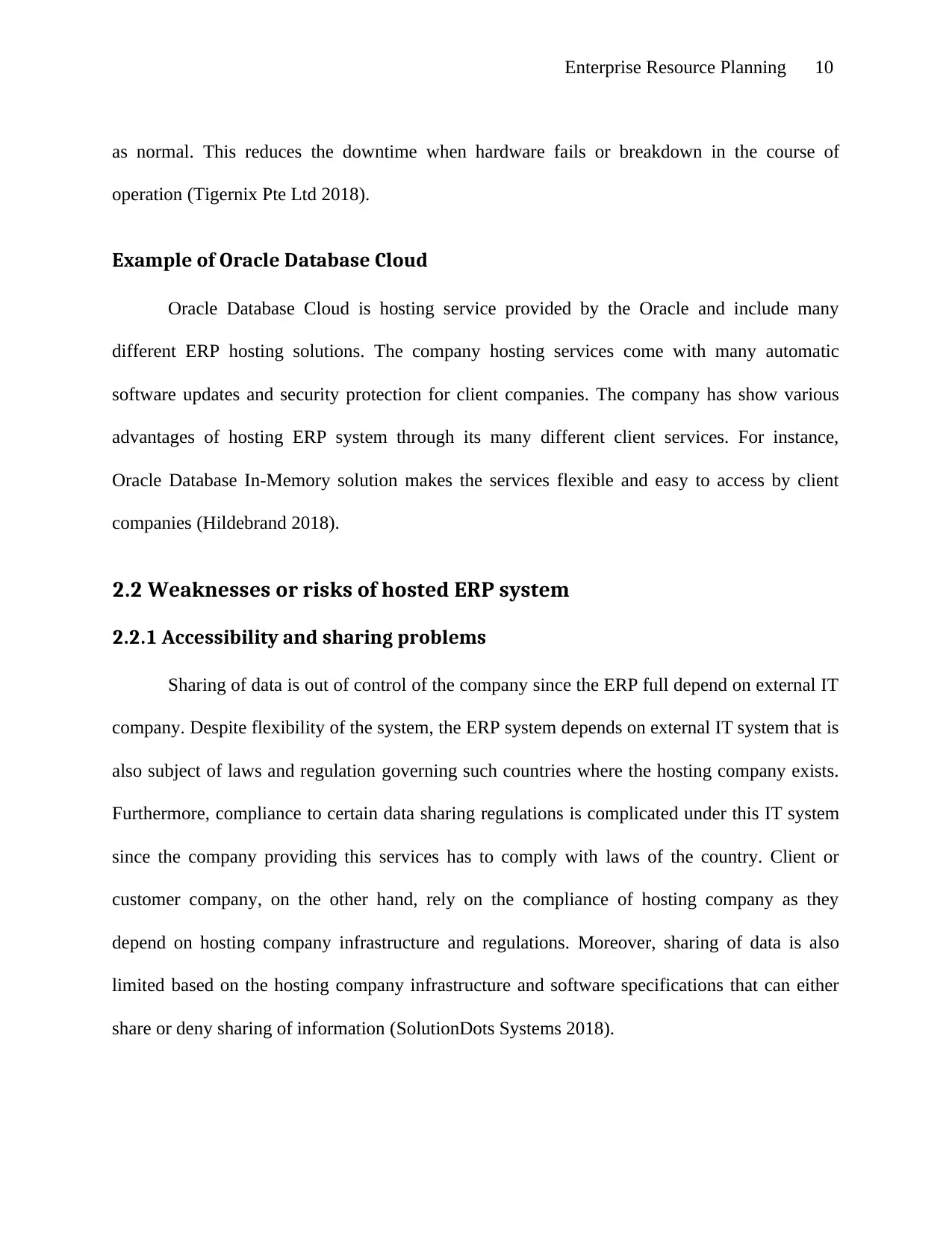
Enterprise Resource Planning 10
as normal. This reduces the downtime when hardware fails or breakdown in the course of
operation (Tigernix Pte Ltd 2018).
Example of Oracle Database Cloud
Oracle Database Cloud is hosting service provided by the Oracle and include many
different ERP hosting solutions. The company hosting services come with many automatic
software updates and security protection for client companies. The company has show various
advantages of hosting ERP system through its many different client services. For instance,
Oracle Database In-Memory solution makes the services flexible and easy to access by client
companies (Hildebrand 2018).
2.2 Weaknesses or risks of hosted ERP system
2.2.1 Accessibility and sharing problems
Sharing of data is out of control of the company since the ERP full depend on external IT
company. Despite flexibility of the system, the ERP system depends on external IT system that is
also subject of laws and regulation governing such countries where the hosting company exists.
Furthermore, compliance to certain data sharing regulations is complicated under this IT system
since the company providing this services has to comply with laws of the country. Client or
customer company, on the other hand, rely on the compliance of hosting company as they
depend on hosting company infrastructure and regulations. Moreover, sharing of data is also
limited based on the hosting company infrastructure and software specifications that can either
share or deny sharing of information (SolutionDots Systems 2018).
as normal. This reduces the downtime when hardware fails or breakdown in the course of
operation (Tigernix Pte Ltd 2018).
Example of Oracle Database Cloud
Oracle Database Cloud is hosting service provided by the Oracle and include many
different ERP hosting solutions. The company hosting services come with many automatic
software updates and security protection for client companies. The company has show various
advantages of hosting ERP system through its many different client services. For instance,
Oracle Database In-Memory solution makes the services flexible and easy to access by client
companies (Hildebrand 2018).
2.2 Weaknesses or risks of hosted ERP system
2.2.1 Accessibility and sharing problems
Sharing of data is out of control of the company since the ERP full depend on external IT
company. Despite flexibility of the system, the ERP system depends on external IT system that is
also subject of laws and regulation governing such countries where the hosting company exists.
Furthermore, compliance to certain data sharing regulations is complicated under this IT system
since the company providing this services has to comply with laws of the country. Client or
customer company, on the other hand, rely on the compliance of hosting company as they
depend on hosting company infrastructure and regulations. Moreover, sharing of data is also
limited based on the hosting company infrastructure and software specifications that can either
share or deny sharing of information (SolutionDots Systems 2018).
Paraphrase This Document
Need a fresh take? Get an instant paraphrase of this document with our AI Paraphraser
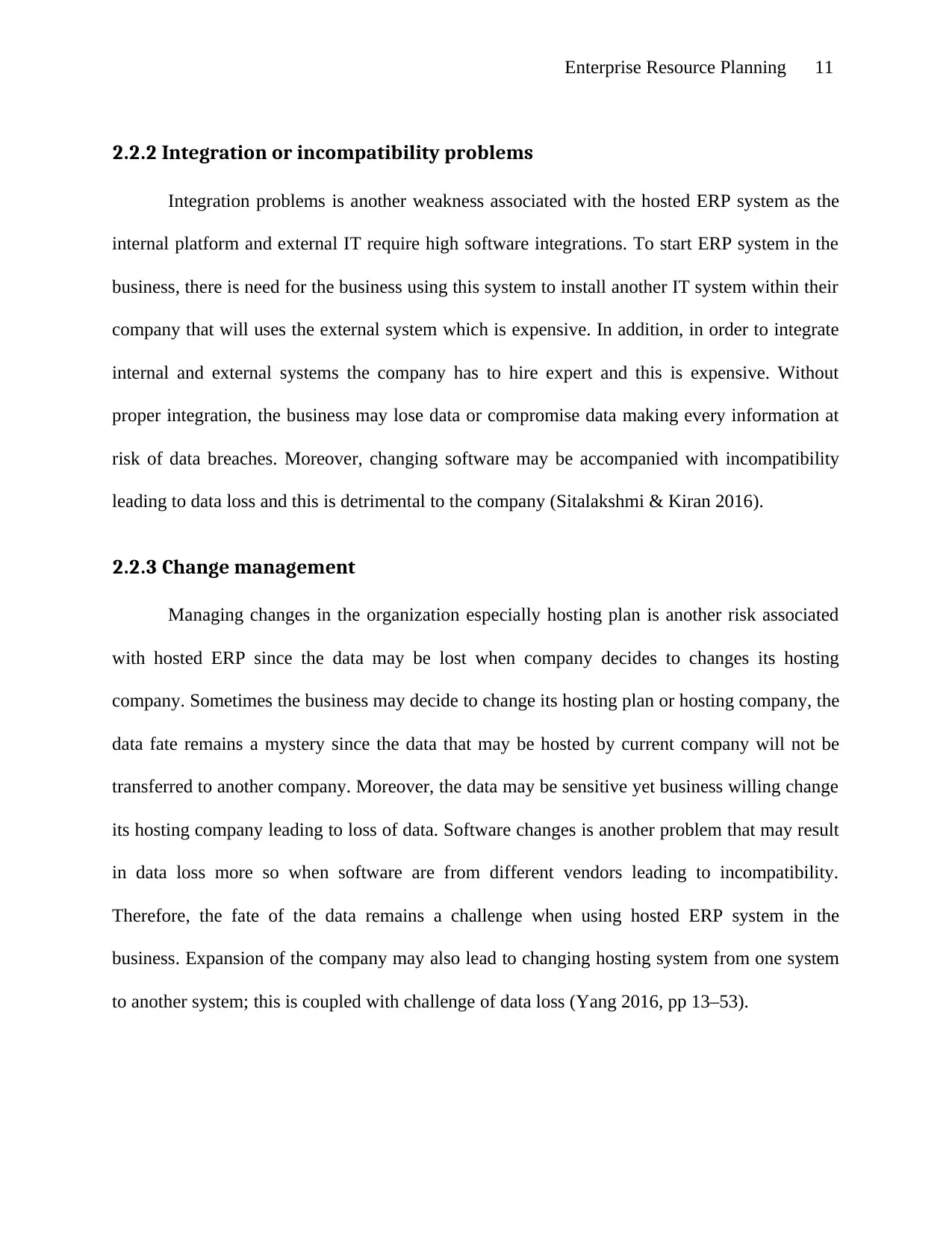
Enterprise Resource Planning 11
2.2.2 Integration or incompatibility problems
Integration problems is another weakness associated with the hosted ERP system as the
internal platform and external IT require high software integrations. To start ERP system in the
business, there is need for the business using this system to install another IT system within their
company that will uses the external system which is expensive. In addition, in order to integrate
internal and external systems the company has to hire expert and this is expensive. Without
proper integration, the business may lose data or compromise data making every information at
risk of data breaches. Moreover, changing software may be accompanied with incompatibility
leading to data loss and this is detrimental to the company (Sitalakshmi & Kiran 2016).
2.2.3 Change management
Managing changes in the organization especially hosting plan is another risk associated
with hosted ERP since the data may be lost when company decides to changes its hosting
company. Sometimes the business may decide to change its hosting plan or hosting company, the
data fate remains a mystery since the data that may be hosted by current company will not be
transferred to another company. Moreover, the data may be sensitive yet business willing change
its hosting company leading to loss of data. Software changes is another problem that may result
in data loss more so when software are from different vendors leading to incompatibility.
Therefore, the fate of the data remains a challenge when using hosted ERP system in the
business. Expansion of the company may also lead to changing hosting system from one system
to another system; this is coupled with challenge of data loss (Yang 2016, pp 13–53).
2.2.2 Integration or incompatibility problems
Integration problems is another weakness associated with the hosted ERP system as the
internal platform and external IT require high software integrations. To start ERP system in the
business, there is need for the business using this system to install another IT system within their
company that will uses the external system which is expensive. In addition, in order to integrate
internal and external systems the company has to hire expert and this is expensive. Without
proper integration, the business may lose data or compromise data making every information at
risk of data breaches. Moreover, changing software may be accompanied with incompatibility
leading to data loss and this is detrimental to the company (Sitalakshmi & Kiran 2016).
2.2.3 Change management
Managing changes in the organization especially hosting plan is another risk associated
with hosted ERP since the data may be lost when company decides to changes its hosting
company. Sometimes the business may decide to change its hosting plan or hosting company, the
data fate remains a mystery since the data that may be hosted by current company will not be
transferred to another company. Moreover, the data may be sensitive yet business willing change
its hosting company leading to loss of data. Software changes is another problem that may result
in data loss more so when software are from different vendors leading to incompatibility.
Therefore, the fate of the data remains a challenge when using hosted ERP system in the
business. Expansion of the company may also lead to changing hosting system from one system
to another system; this is coupled with challenge of data loss (Yang 2016, pp 13–53).
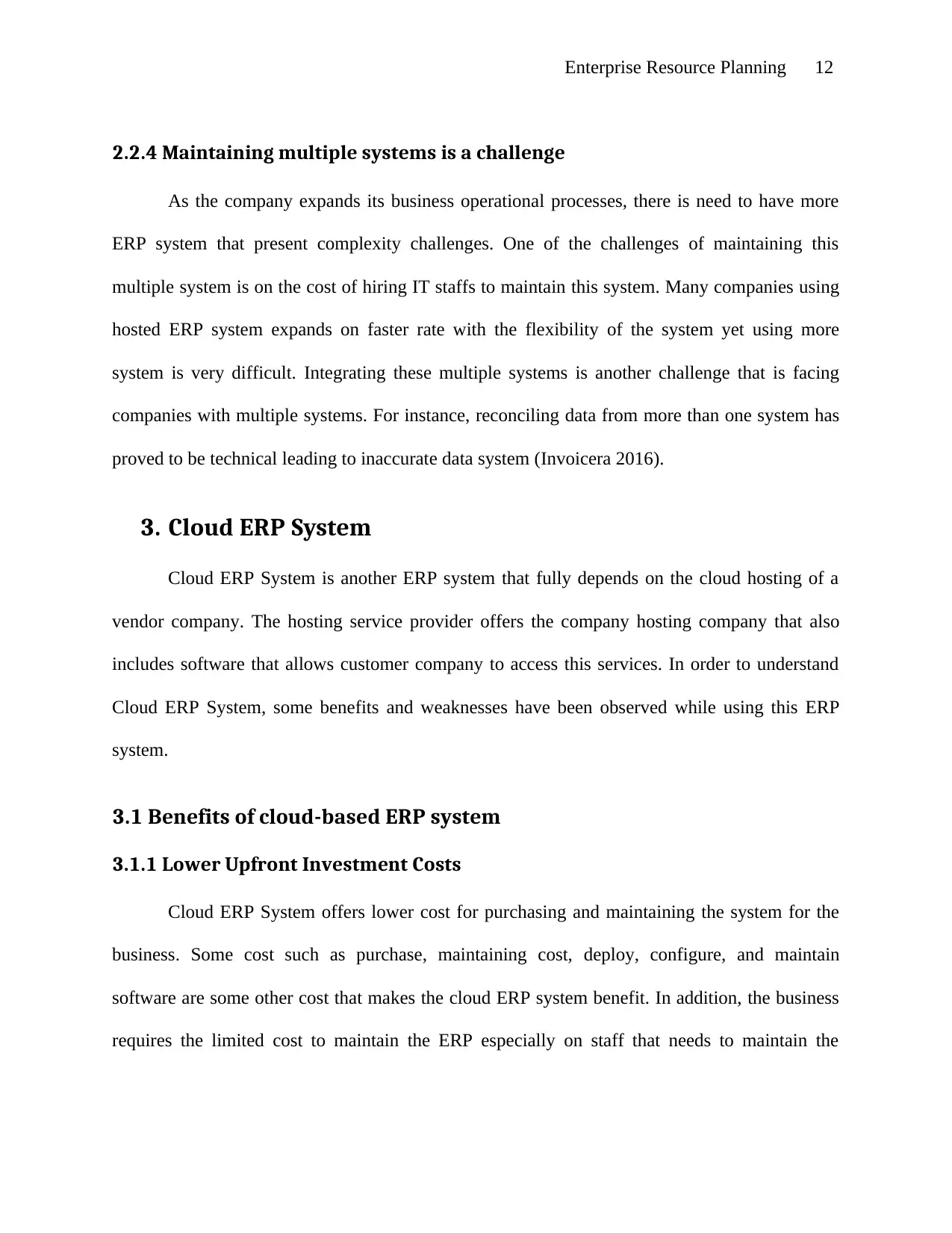
Enterprise Resource Planning 12
2.2.4 Maintaining multiple systems is a challenge
As the company expands its business operational processes, there is need to have more
ERP system that present complexity challenges. One of the challenges of maintaining this
multiple system is on the cost of hiring IT staffs to maintain this system. Many companies using
hosted ERP system expands on faster rate with the flexibility of the system yet using more
system is very difficult. Integrating these multiple systems is another challenge that is facing
companies with multiple systems. For instance, reconciling data from more than one system has
proved to be technical leading to inaccurate data system (Invoicera 2016).
3. Cloud ERP System
Cloud ERP System is another ERP system that fully depends on the cloud hosting of a
vendor company. The hosting service provider offers the company hosting company that also
includes software that allows customer company to access this services. In order to understand
Cloud ERP System, some benefits and weaknesses have been observed while using this ERP
system.
3.1 Benefits of cloud-based ERP system
3.1.1 Lower Upfront Investment Costs
Cloud ERP System offers lower cost for purchasing and maintaining the system for the
business. Some cost such as purchase, maintaining cost, deploy, configure, and maintain
software are some other cost that makes the cloud ERP system benefit. In addition, the business
requires the limited cost to maintain the ERP especially on staff that needs to maintain the
2.2.4 Maintaining multiple systems is a challenge
As the company expands its business operational processes, there is need to have more
ERP system that present complexity challenges. One of the challenges of maintaining this
multiple system is on the cost of hiring IT staffs to maintain this system. Many companies using
hosted ERP system expands on faster rate with the flexibility of the system yet using more
system is very difficult. Integrating these multiple systems is another challenge that is facing
companies with multiple systems. For instance, reconciling data from more than one system has
proved to be technical leading to inaccurate data system (Invoicera 2016).
3. Cloud ERP System
Cloud ERP System is another ERP system that fully depends on the cloud hosting of a
vendor company. The hosting service provider offers the company hosting company that also
includes software that allows customer company to access this services. In order to understand
Cloud ERP System, some benefits and weaknesses have been observed while using this ERP
system.
3.1 Benefits of cloud-based ERP system
3.1.1 Lower Upfront Investment Costs
Cloud ERP System offers lower cost for purchasing and maintaining the system for the
business. Some cost such as purchase, maintaining cost, deploy, configure, and maintain
software are some other cost that makes the cloud ERP system benefit. In addition, the business
requires the limited cost to maintain the ERP especially on staff that needs to maintain the
⊘ This is a preview!⊘
Do you want full access?
Subscribe today to unlock all pages.

Trusted by 1+ million students worldwide
1 out of 20
Related Documents
Your All-in-One AI-Powered Toolkit for Academic Success.
+13062052269
info@desklib.com
Available 24*7 on WhatsApp / Email
![[object Object]](/_next/static/media/star-bottom.7253800d.svg)
Unlock your academic potential
Copyright © 2020–2025 A2Z Services. All Rights Reserved. Developed and managed by ZUCOL.



